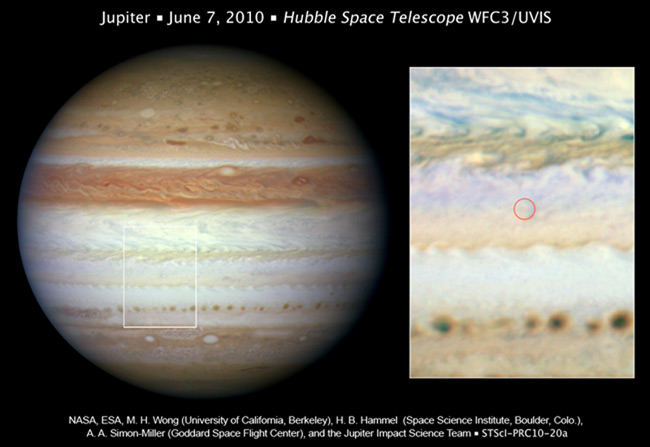
© NASA, ESA, M.H. Wong (University of California, Berkeley), H.B. Hammel (Space Science Institute, Boulder, Colo.), A.A. Simon-Miller (Goddard Space Flight Center), and the Jupiter Impact Science Team.Detailed observations made by the Hubble Space Telescope have found that the flash of light seen June 3 on Jupiter came from a giant meteor burning up high above the planet's cloud tops. The space visitor did not plunge deep enough into the atmosphere to explode and leave behind any telltale cloud of debris, as seen in previous Jupiter collisions.
The mystery fireball that smacked into Jupiter on June 3 has been identified as a giant meteor that plunged into the planet's atmosphere and burned up high above its cloud tops, according to new observations from the Hubble Space Telescope.
The
cosmic intruder did not dive deep enough into Jupiter's atmosphere to explode, which explains the lack of any telltale cloud of debris, as was seen in previous Jupiter collisions, said Hubble astronomers, who described the meteor's size as "giant" in a Wednesday announcement.
"We suspected for this 2010 impact there might be no big explosion driving a giant plume, and hence no resulting debris field to be imaged," said Heidi Hammel, a veteran Jupiter observer at the Space Science Institute in Boulder, Colo., in a statement. "There was just the meteor, and Hubble confirmed this."
The meteor was huge, but not as large as the object that struck Jupiter in July 2009, or the shattered comet fragments that hit the gas giant planet in 1994, researchers said. [
Gallery: Jupiter's 2009 crash.]
The new Hubble observations also allowed scientists to get a close-up look at changes in Jupiter's atmosphere, following the disappearance of the dark
Southern Equatorial Belt (SEB) several months ago.
In the latest Hubble view, a slightly higher altitude layer of white ammonia ice crystal clouds appears to obscure the deeper, darker belt clouds.
"Weather forecast for Jupiter's South Equatorial Belt: cloudy with a chance of ammonia," Hammel said.
The researchers predict that these ammonia clouds will likely clear out in a few months, as it has typically done in the past.
